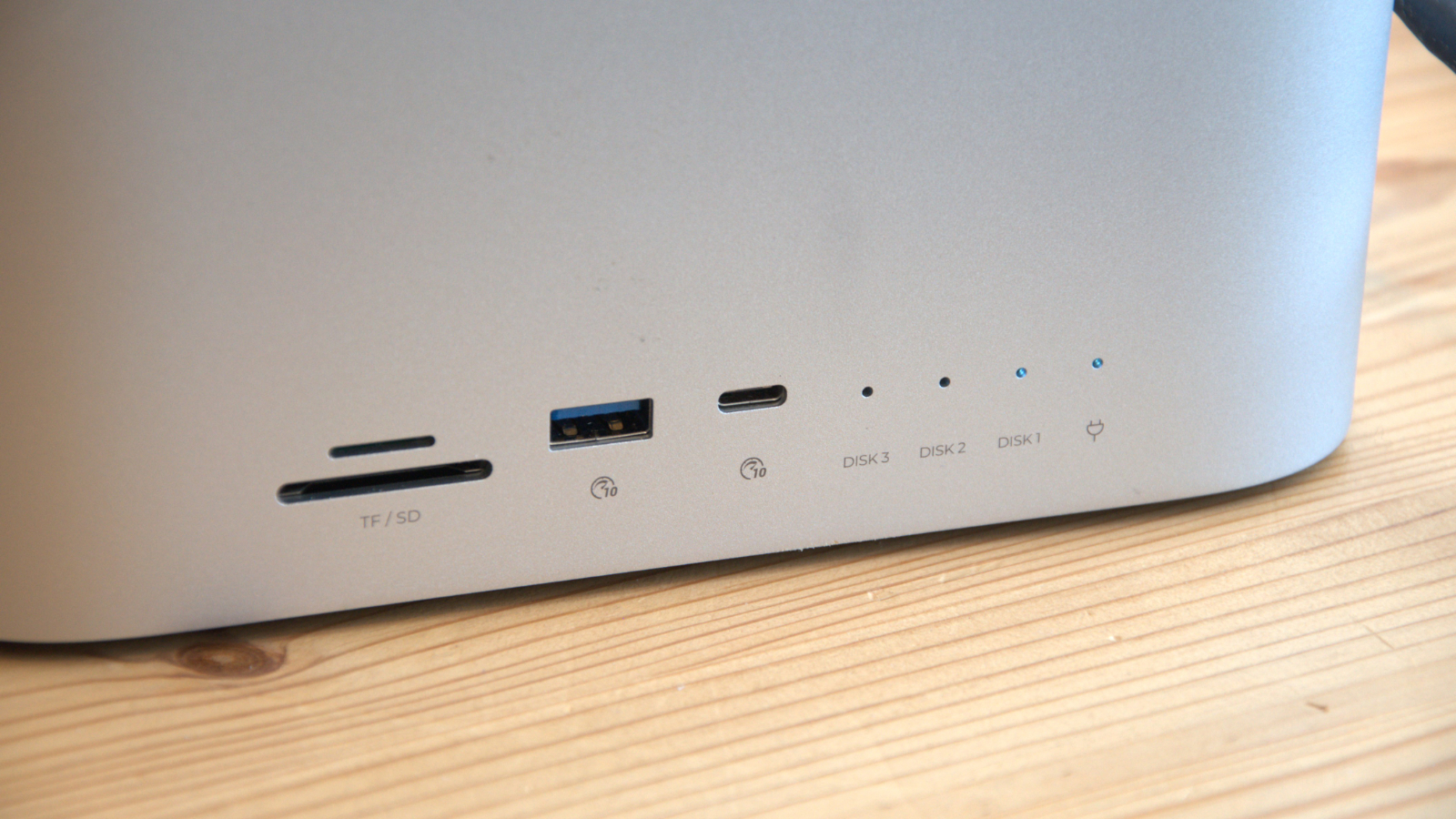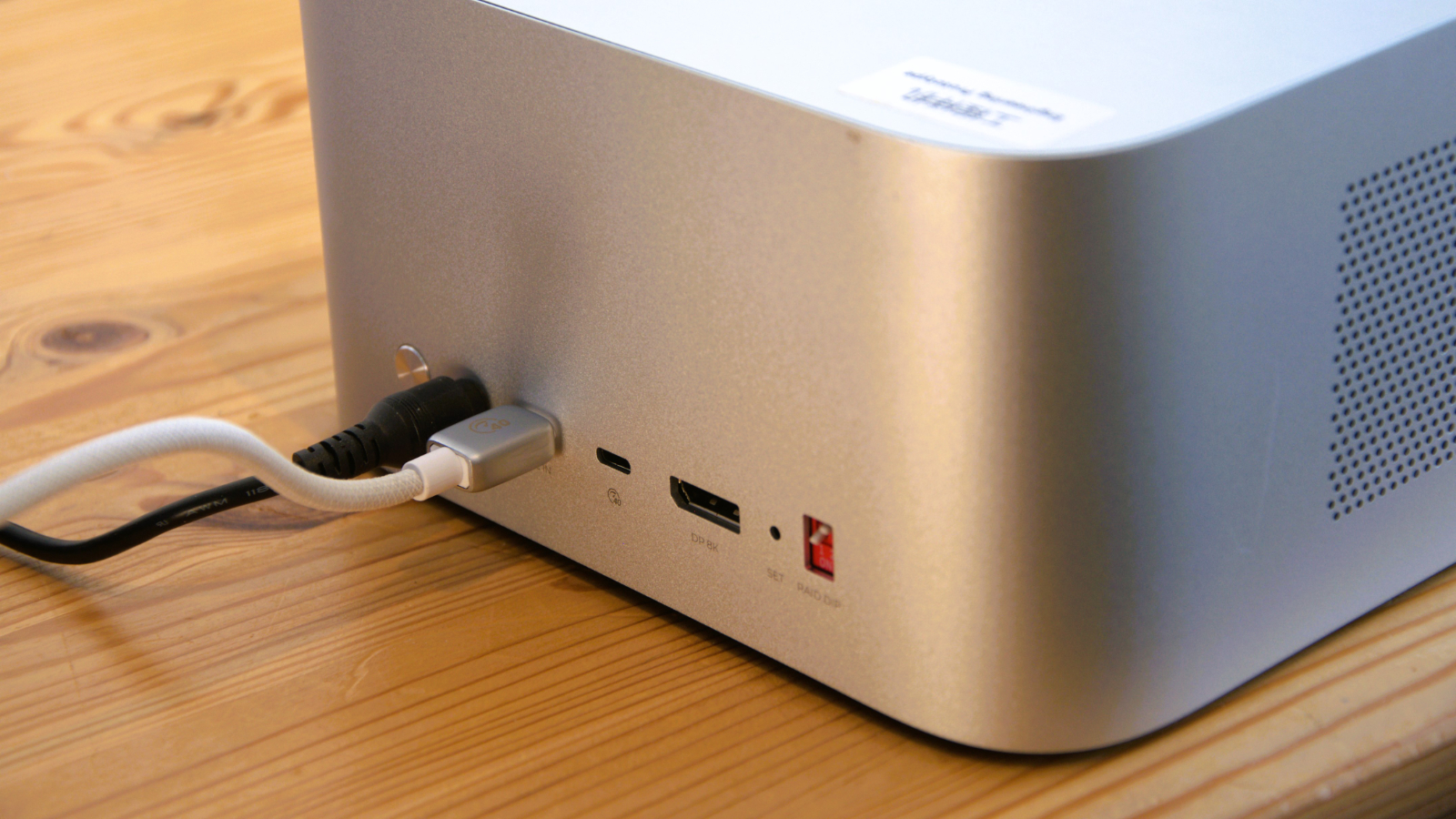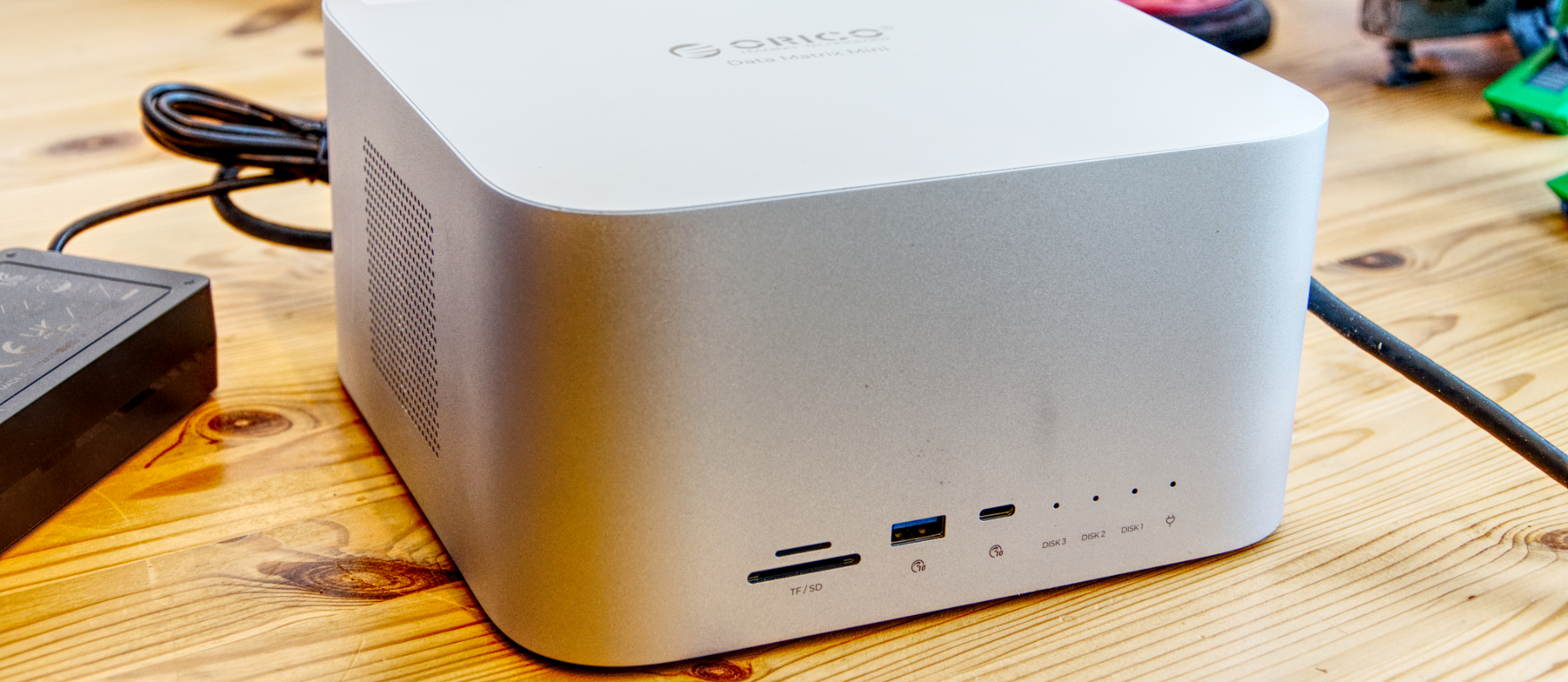Early Verdict
This concept went wrong in the inception stage when Orico decided its target audience was Apple Mac owners, then compounded this mistake by using Kickstarter to promote it. External RAID arrays, where you can't replace the drives, aren't a thing people need.
Pros
- +
Looks stylish
- +
Thunderbolt connectivity
- +
Daisy-chain storage
Cons
- -
Expensive
- -
Kickstarter promotion
- -
Drives can't be replaced
- -
SSD can't be used for cache
- -
Big and heavy
Why you can trust TechRadar
Orico Data Matrix Pro: 30-second review
The Orico brand is well-considered for its inexpensive range of external drive enclosures, but the Orico Data Matrix Mini products are a significant diversion.
There are three options: the Data Matrix Elite, Data Matrix Pro, and Data Matrix Ultra, with one, two, or five hard drives mounted internally.
Thunderbolt technology connects the PC or Apple Mac, and each of these external drives incorporates a Thunderbolt hub, enabling five of them to be daisy-chained for a substantial amount of capacity.
All these units are supplied with drives pre-installed, negating the possibility of finding a deal on storage. All units come with conventional SATA drives and a single M.2 SSD, and the capacities of these are combined for no obvious good reason.
Therefore, the Data Matrix Elite can come with a 4TB, 8TB, 16TB, and 22TB drive and with a 1TB SSD, making for total capacities of 5TB, 9TB, 17TB and 23TB.
The Matrix Pro can have 10TB, 18TB, 34TB or 46TB, as it comes with a 2TB SSD. The Matrix Ultra is available with 42TB, 82TB or a whopping 112TB, and it also has a 2TB SSD.
But, here's where things start to go South. Orico put these devices on Kickstarter, where the Data Matrix Elite starts at $699 for a 5TB model, going up to $4999 for the 112TB model.
While the SSD is user-upgradable, the internal hard drives aren't accessible for replacement or upgrades. The drive configuration of the unit is set by dip switches before use, and once those drives are formatted, they can't be altered without erasing them.
Other than increasing the size of the SSD, the only option that the user has is to set the drives as RAID 0, 1, spanned or JBOD. In theory, it might be possible to combine multiple units using software RAID on the computer, and that would offer greater performance but trade the reliability should any of the units or drives fail.
As an ex-IT professional, there is so much about this setup that represents a red flag. I'd recommend looking at what TerraMaster offers in external Thunderbolt storage arrays before backing this Kickstarter.
Orico Data Matrix Pro: Price and availability

- How much does it cost? From around $699
- When is it out? Available now
- Where can you get it? Pledges on Kickstarter
Kickstarter isn't a promotional tool, and Orico doesn't need the extra investment to make this product a reality.
The Data Matrix Elite line starts at $699 for a 4TB WD Red and an unbranded 1TB SSD, which would cost around $160 if bought separately. You could achieve the same experience with a $200 Thunderbolt hub and two drive enclosures, which would cost at most another $100. That's $460 of technology with a Kickstarter price of $699 in a heavy aluminium box.
At the most expensive end of the spectrum, the Matrix Ultra with 112TB has a 2TB SSD ($150), five 22TB WD Red drives ($450 each = $2250), and a $200 Thunderbolt dock. That makes roughly $2600 of hardware for a $4999 investment. These quoted numbers are retail costs, not what Orico would pay for OEM technology.
There are numerous ways to connect this capacity by Thunderbolt, including the TerraMaster D5, the enclosure of which is only $699.99. It can deliver a similar option for around $3000 for the D5 and drives when configured.
Making this specifically for Apple Mac users seems to have affected the price of the Data Matrix devices.
Orico Data Matrix Pro: Specs
| Item | Spec |
|---|---|
| Hardware: | Orico Data Matrix Pro 9T |
| Technology: | Thunderbolt 3/4, USB 4.0, USB 3.2 |
| Ports | 1x CFexpress Type-B slot1x Thunderbolt 4 USB-C (uplink)1x Thunderbolt 4 USB-C (downlink)1x DisplayPort 1.41x USB 3.2 Type A1x USB 3.2 Type-C1x SD Card reader (Micro SD and SD) |
| PSU: | 180W |
| Weight: | Matrix Pro 2930g (6.456lbs) PSU and power cable 723gTotal 3653g (8.05lbs) |
| Dimensions: | 197 x 197 x 113mm |
Orico Data Matrix Pro: Design

- A Thunderbolt Dock with drives
- No drive replacements
- Single SSD
For our assessment, Orico sent us an engineering sample of the Data Matrix Pro with a single 1TB SSD and two 4TB WD Red hard drives.
The design of this enclosure was designed to please Apple Mac users who can afford the Mac Studio or Mac Pro without the need to remortgage.
It's not that this hardware won't work with a PC, as we exclusively tested it without a single Apple product. Still, Orico promotes it as a new hybrid storage system for Apple Macs in much of its marketing materials.
What Orico did was take a Thunderbolt dock, like the 12-in-1 Thunderbolt 4 Docking Station (ORICO-TB4) it already makes, add electronics for SATA and M.2 drive connections, and place it all in a disturbingly heavy aluminium box.
What makes the drive so heavy is that the hard drives are pre-installed, although the power supply isn't integrated.
The only user access is on the underside of the Data Matrix Pro. Once a Torx screwdriver is used to remove the cover, it is possible to exchange the 1TB M.2 drive for something larger with a 2280 form factor drive. There is no access to the internal hard drives, so if they die or you want larger drives, then you either invalidate the warranty and get inside by pulling off the rubber feet and removing screws, or you accept its scrap.
This seems remarkably short-sighted, given that the major competitors for this product, the TerraMaster D3 and D5, are made like NASs with easily swappable drives.
One confusing aspect of this product is that Orico refers to these boxes as having Hybrid storage, inferring that, in some way, the hard drives and the SSD are combined. When on a PC, at least, they are not. Things might be different on the Mac, but on the PC, the hard drives appear as either one drive or multiple drives depending on the configuration, and the SSD appears as a drive. However, that arrangement is described; 'hybrid' doesn't appear to fit its specification.
What's nice about the Data Matrix Pro is that all the Thunderbolt Dock technology is exposed, providing dual SD card slots, USB ports, DisplayPort and a Thunderbolt downstream.

The one feature aimed at video editors is the CFexpress Type-B slot, though it is debatable how many use this over faster external Thunderbolt SSDs these days.
The critical inclusion is the Thunderbolt downstream port, which allows multiple Matrix boxes to be chained together to add extra capacity as needed. The limit is five boxes, which, if you used the Elite Ultra designs with 112TB, would provide a total of 560TB should you own a desk strong enough to place them. Oh, and spare the $25,000 needed to pay for them.
On the Matrix Elite, the two internal hard drives can be configured using a small dip-switch to be mirrored (RAID 1), striped for performance (RAID 0), spanned or seen as individual drives (JBOD).
That this wasn't configurable from the computer using an app is disappointing, and changing involves setting the new pin positions and then resetting the box.]
Once the changes have been made, you must reinitialise the drive(s) with the computer and format them according to the file system you like best.
The clunky nature of that exercise hints at a user experience we'll discuss next.
Orico Data Matrix Pro: User experience
- Raw drive performance
- No SSD caching
- No software utilities
Thunderbolt is a wonderful technology that can, in both TB3 and TB4, transfer up to 40Gbps over relatively short distances. And by 'short,' we mean longer than the remarkably disappointing 20cm cable that Orico provided with its hardware. Orico will sell you a longer cable for an extra $23, though cheaper ones are available from Amazon if you don't pick the Apple-branded ones.
With 40Gbps to play with, you might expect the external storage on this system to be sparkling, but that would be a wrong assumption.
The internal hard drives are SATA, and even when combined in RAID 0, the best performance we achieved was a read speed of 390MB/s and a write speed of 235MB/s.
Using RAID 5 with five drives on the Matrix Ultra might boost these numbers somewhat, perhaps doubling the scores, but compared with SSDs, it's nothing to write home about.
To make these drives suitable for a video editing suite, ideally, the drives should be cached using the M.2 NVMe drive, but that isn't a feature the Matrix Pro offers.
The SSD could be seen independently in the system, and it performed at 3074MB/s reads and 2347MB/s writes, making it at least eight times faster than the two combined hard drives.
But, if this drive were inside the host computer, it would probably run even faster, and because it isn't possible to use it to cache, there seems to be no advantage in having it inside the Matrix Pro.
The quoted speed of the CFexpress Type-B slot is 1,500Mb/s, should you have media of that specification. That speed assumes you copy the contents to the SSD, not the hard drives.

When I discovered that the internal hard drives weren't user-accessible, a mistake even Western Digital didn't make with the My Cloud Duo, suggested a lack of joined-up thinking. But when it transpired that the SSD slot was merely a means to bolt on another 1TB or 2TB of drive space and not cache the drives, the Matrix Pro started to look more like a potential boat anchor.
For those who own a Mac or PC and want to edit video offline, numerous better options exist than this configuration. One is to use a device like the SanDisk Professional G-RAID Shuttle with up to eight drives or use Thunderbolt to 10GbE adapters and a NAS box that can use SSD as a cache.
Dual 10GbE Lines will move close to 2000Mb/s, the contents of the NAS will be accessible by more than one computer, and drives can easily be replaced or upgraded.
Compared to these other choices, the Matrix Elite and its brothers appear to be the least flexible option and an expensive way to increase a computer's storage capacity.

Orico Data Matrix Pro: Verdict
The best aspect of this design is the integral Thunderbolt dock, which enables you to connect an external monitor and chain more Thunderbolt devices. However, a Thunderbolt dock provides that functionality inherently and typically costs between $200 and $300.
The dip-switch set RAID technology is of limited use. If either of the drives dies, all the data will be gone for those who choose RAID 0 or spanning options. The only data protection setting is RAID 1 (mirror), and should one of the drives fail, then there isn't any way to put a replacement in and re-sync.
The single M.2 SSD also has zero resilience and can't be used to improve the poor performance of conventional SATA drives, which is a double fail.
Then maybe we haven't understood this product, and it does something amazing with caching that failed to work in our engineering sample. That could be a possibility.
But, every NAS that uses SSD caching only offers read and write caches with two physical drives, and this only has one.
Whatever the truth, this isn't a Kickstarter that this reviewer is inclined to back.
Mark is an expert on 3D printers, drones and phones. He also covers storage, including SSDs, NAS drives and portable hard drives. He started writing in 1986 and has contributed to MicroMart, PC Format, 3D World, among others.
What is a hands on review?
Hands on reviews' are a journalist's first impressions of a piece of kit based on spending some time with it. It may be just a few moments, or a few hours. The important thing is we have been able to play with it ourselves and can give you some sense of what it's like to use, even if it's only an embryonic view. For more information, see TechRadar's Reviews Guarantee.

